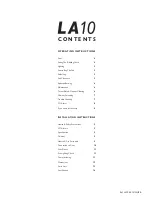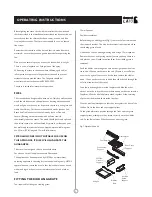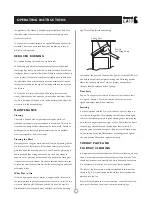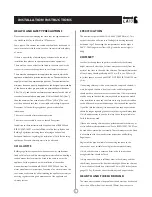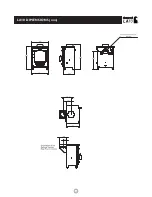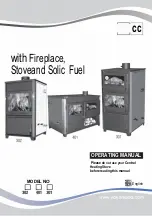
the grate bars. The ashpan is handled using the tool provided. Care
should be taken to ensure that ash is cool before emptying it into
plastic liners or bins.
To make ash removal easier there is a special Charnwood ash carrier
available. This may be purchased from your supplier or, in case of
difficulty, from ourselves.
For reduced burning the fire door must be closed.
When burning wood in areas that are not smoke controlled, load
some large logs on the fire and allow to burn for half an hour before
closing the front air control slider (this will help to reduce tar deposits
in the chimney.) Leave the airwash control slightly open to help keep
the glass clear. Some experimentation may be necessary to find the
setting most suitable for the type of fuel being used and the draw on
the chimney.
To revive the fire, empty the ashpan, (if burning fuel other than
wood), riddle the fire, and open the air controls to maximum. When
the fire is burning well load on more fuel as necessary and adjust the
air controls to the desired setting.
REDUCED BURNING
MAINTENANCE
Cleaning
Cleaning the Glass
When Not in Use
If the fire is going to be out of use for a long period (for instance in
the summer) then to prevent condensation, and hence corrosion, the
air control should be left fully open and the fire door left ajar. It Is
also advisable to sweep the chimney and clean out the fire. Spraying
The stove is finished with a high temperature paint which will
withstand the temperatures encountered in normal use. This may be
cleaned with a damp lint-free cloth when the stove is cold. Should re-
painting become necessary, high temperature paints are available
from your supplier or from stove shops.
Most deposits on the glass may be burnt off simply by running the fire
at a fast rate for a few minutes. If it becomes necessary to clean the
glass then open the door and allow it to cool. Clean the glass using a
damp cloth and then wiping over with a dry cloth. Any stubborn
deposits on the glass may be removed with a proprietary stove glass
cleaner or ceramic hob cleaner. Do not use abrasive cleaners or pads
as these can scratch the surface which will weaken the glass and cause
premature failure
the inside of the door and firebox with a light oil, such as WD40, will
also help to keep all internal parts working well.
Door Seals
For the fire to operate correctly it is important that the door seals
are in good condition. Check that they do not become worn or
frayed and replace them when necessary.
Servicing
It is recommended that the fire is serviced once a year to keep it in
first class working order. After cleaning out the firebox thoroughly,
check that all internal parts are in good working order, replacing any
parts that are beginning to show signs of wear. Check that the doors
seals are in good condition and that the door seals correctly. A
servicing guide is available on request. Repairs or modifications may
only be carried out by the Manufacturer or their approved agents.
Use only genuine Charnwood replacement parts.
After long periods
where the fire has been out of use, the chimney and appliance
flueways should be cleaned before lighting.
It is important that the throat plate and all the stove flueways are kept
clean in order to prevent potentially dangerous fume emission. They
should be cleaned at least monthly, and more frequently if necessary.
It is necessary to let the fire out to carry out these operations.
The front of the throat plate is pulled forward and then lowered as
shown in Fig. 3. Any sooty deposits should then be swept from the
plate and into the fire.
Return the throat plate to its correct position - raise the front of the
plate, push it back and then lower it onto the retaining lugs.
THROAT PLATE AND
FLUEWAY CLEANING
6
®
OPERATING INSTRUCTIONS
Throat Plate
Pull Up
and Swing Down
Fig.3. Throat Plate Position and Lowering
charnwood
Summary of Contents for LA10
Page 1: ...Operating Installation Instructions charnwood ...
Page 2: ......
Page 12: ... LA10 DIMENSIONS mm 12 charnwood ...
Page 15: ......



